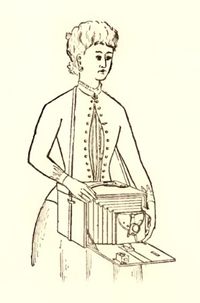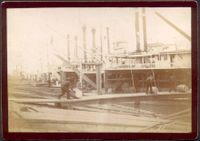No. 5 Folding Kodak and No. 5 Folding Kodak Improved
No. 5 Folding Kodak
No. 5 Folding Kodak Improved
The Folding Kodaks of the early 1890s were among the first bellows cameras that were designed as hand held cameras. When closed they resemble a satchel, so they are also known among collectors as 'satchel Kodaks'. One side of the satchel is hinged and folds down to form a bed over which the lensboard can be pulled out of the case.
During transportation the bellows, lens and shutter and all other parts are contained in the case, which can be carried over the shoulder on a long leather strap. The top of the box is hinged and gives access to the rollholder, plate holders and ground glass.
- The No. 5 takes pictures of 5 by 7 inch (13 x 18 cm).
- The outer dimensions when closed changed over the years. The earliest models measure 6 1/4 x 7 x 9 inch (16 x 18 x 23 cm). During 1894-1896 the size was 7.5 x 9.25 x 10.125 inches (19 x 23 x 26 cm). The last model measures 7.5 x 9 x 9 3/4 inch (19 x 23 25 cm). It is not really a small camera, but for the early 1890's is was quite a transportable apparatus.
- Price increased from $ 60 to $ 75.
This No. 5 Folding Kodak in the video is a very special specimen: it once was the property of princess Maria Theresa von Braganza, infante of Portugal, (24 August 1855 – 12 February 1944). She became by marriage an Archduchess of Austria and also sister-in-law of Emperors Franz Joseph I of Austria and Maximilian I of Mexico, as well as the stepmother of Franz Ferdinand von Österreich-Este. Since 1896 Franz Ferdinand was heir to the throne of Austria-Hungary . His assassination in Sarajevo on June 28th 1914 is considered to be the trigger of the First World War.
Maria Theresa was a keen amateur photographer and many of her photographs can be found in online collections, showing the life of the highest European aristocracy.
When the camera came on the market in 1890 it was called No. 5 Folding Kodak. It had a smaller lens panel than the later models. It only could take photos on film that was loaded in a darkroom on a Eastman-Walker rollholder. From 1892 the cameras were changed so that they could accomodate plate holders as well.
When the Folding Kodaks were introduced in 1890, they were intended for the snapshooter who did not want to bother about the technique of photography. But from 1893 on the cameras featured more complicated options and were aimed at the more "serious" amateur photographer. They were now called "Folding Kodak Improved":
- It had a much wider lensboard
- The lensboard had rising and horizontal sliding movements
- It had a double swing back.
- The drop down bed had extra hinges so that the front half of the bed can be swung down even more. This was neccesary when using wide angle lenses (otherwise the front part of the bed would show in the picture).
The camera was discontinued in 1897. The satchel Kodak design was outdated by then. In 1897 the No. 4 Cartridge Kodak came on the market, followed in 1898 by the No. 5 Cartridge Kodak for 5 x 7 inch photos. These were more compact and could be used with daylight loading rollfilms and plates as well.
In total 4900 No. 5 Folding Kodaks were made.
The Folding Kodak could be used on a tripod, but also as a handheld camera. Illustration from No. 5 Folding Kodak Instruction Manual.
5 x 7" Photo made with a No. 5 Folding Kodak

